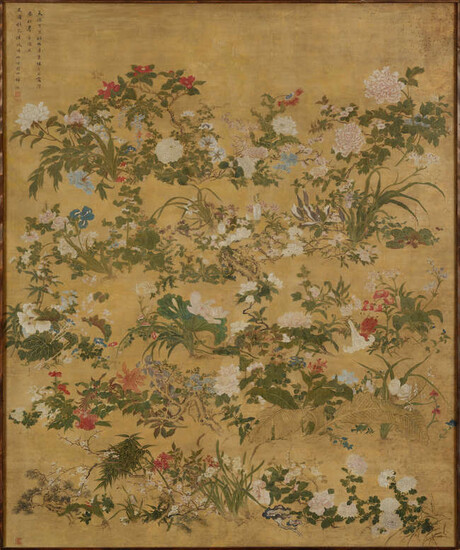TIAN JINJIANG 田锦江 (CHINA, ACTIVE 19TH CENTURY) HUNDRED...
TIAN JINJIANG 田锦江 (CHINA, ACTIVE 19TH CENTURY)
HUNDRED FLOWERS 百花齐放 AFTER XU CHONGSI 徐崇嗣 (CHINA, LATE 10TH TO 11TH CENTURY)
Ink and colours on silk
Laid on wooden panel and framed
Inscribed with a calligraphy to the upper left
Titling it “All years flowers”
Locating it in Yishan (峄山), Shandong Province
Signing the painting Tian Jinjiang (田锦江)
Cyclically dating it to the 9th day of the 9th month of a dingyou year (丁酉) corresponding to 1837
205 x 172 cm
Notes:
1. The calligraphy reads as follow “天保丁酉秋九月重阳之日写诗 春秋群芳团具 又逋稚兄结玩崎山竹园 田锦江”, lit. “On this day of the double Yang (重陽), in the dingyou year (丁酉) of the Tianbao period, I offer to my elder (兄) Buzhi this painting depicting flowers of all seasons (羣芳). Written by the author, Tian Jinjiang, in the bamboo grove garden of Yishan”.
2. “Chongyang” (重陽), i.e. the “Double Yang”, is related to the ninth day of the ninth moon, i.e. the Chrysanthemum festival, also known as The Double Ninth Festival or Chongyang Festival. The festival began as early as the Warring States Period (475 - 221 BC). According to the yin/yang dichotomy that forms a basis to the Chinese world view, yin represents the elements of darkness and yang represents life and brightness. The number nine is regarded as yang. The ninth month also heralds the approach of winter. It is a time when the living need warm clothing, and filial Chinese sons and daughters extended this to make the festival a time for providing winter clothes for their ancestors.
3. This painting has been painted after a famous model by Xu Chongsi 徐崇嗣, a native of Jiangning and painter of the Northern Song Dynasty renowned for his paintings of flowers. His fame went throughout centuries and major painters took their inspiration from his work.
4. For a related Hundred Flowers painting after the same artist, please refer to a work by Yun Shouping 恽寿平 (1633-1690) also known as Nantian 南田 offered at Christie’s Hong Kong,China, 2003/07/06, lot 474. Please also refer to a painting by Cai Han 蔡含 (1641-1686) offered at Sungari International Auction Co., Ltd, Beijing, China, 2020/10/17, lot 893.
丝绸水墨画《百花齐放》
Sale price
Estimate
Time, Location
Auction House
TIAN JINJIANG 田锦江 (CHINA, ACTIVE 19TH CENTURY)
HUNDRED FLOWERS 百花齐放 AFTER XU CHONGSI 徐崇嗣 (CHINA, LATE 10TH TO 11TH CENTURY)
Ink and colours on silk
Laid on wooden panel and framed
Inscribed with a calligraphy to the upper left
Titling it “All years flowers”
Locating it in Yishan (峄山), Shandong Province
Signing the painting Tian Jinjiang (田锦江)
Cyclically dating it to the 9th day of the 9th month of a dingyou year (丁酉) corresponding to 1837
205 x 172 cm
Notes:
1. The calligraphy reads as follow “天保丁酉秋九月重阳之日写诗 春秋群芳团具 又逋稚兄结玩崎山竹园 田锦江”, lit. “On this day of the double Yang (重陽), in the dingyou year (丁酉) of the Tianbao period, I offer to my elder (兄) Buzhi this painting depicting flowers of all seasons (羣芳). Written by the author, Tian Jinjiang, in the bamboo grove garden of Yishan”.
2. “Chongyang” (重陽), i.e. the “Double Yang”, is related to the ninth day of the ninth moon, i.e. the Chrysanthemum festival, also known as The Double Ninth Festival or Chongyang Festival. The festival began as early as the Warring States Period (475 - 221 BC). According to the yin/yang dichotomy that forms a basis to the Chinese world view, yin represents the elements of darkness and yang represents life and brightness. The number nine is regarded as yang. The ninth month also heralds the approach of winter. It is a time when the living need warm clothing, and filial Chinese sons and daughters extended this to make the festival a time for providing winter clothes for their ancestors.
3. This painting has been painted after a famous model by Xu Chongsi 徐崇嗣, a native of Jiangning and painter of the Northern Song Dynasty renowned for his paintings of flowers. His fame went throughout centuries and major painters took their inspiration from his work.
4. For a related Hundred Flowers painting after the same artist, please refer to a work by Yun Shouping 恽寿平 (1633-1690) also known as Nantian 南田 offered at Christie’s Hong Kong,China, 2003/07/06, lot 474. Please also refer to a painting by Cai Han 蔡含 (1641-1686) offered at Sungari International Auction Co., Ltd, Beijing, China, 2020/10/17, lot 893.
丝绸水墨画《百花齐放》



